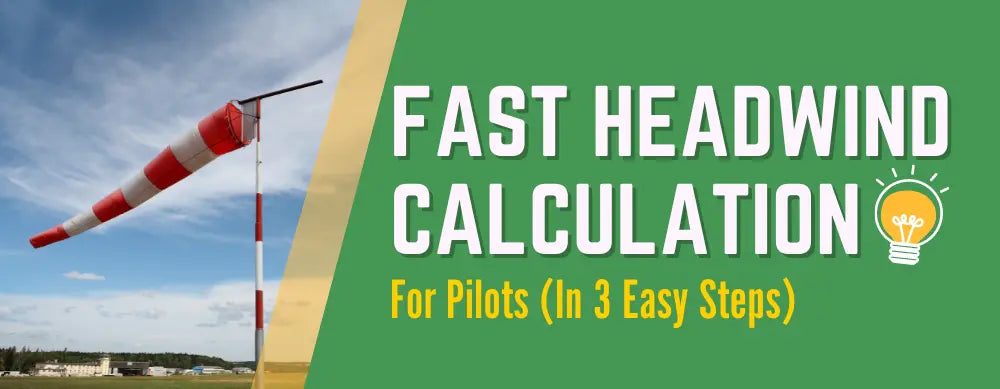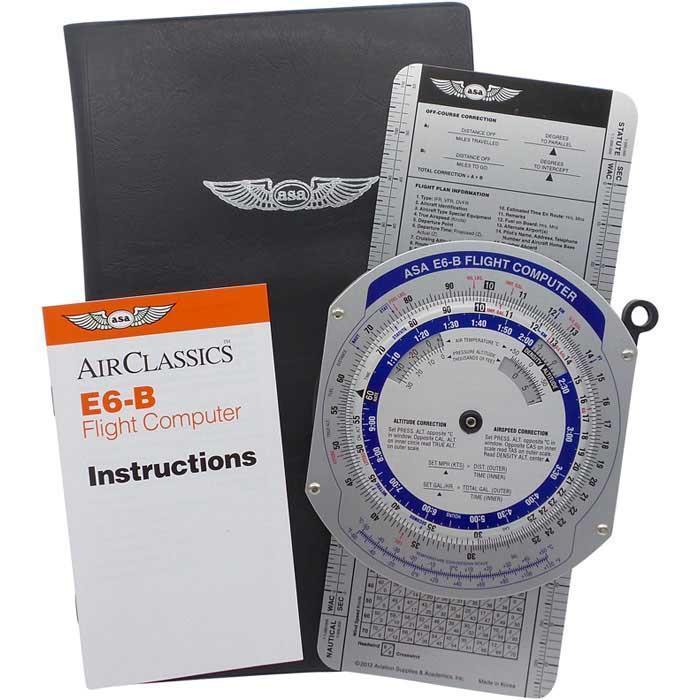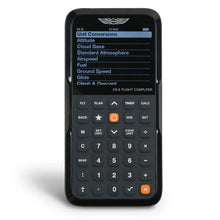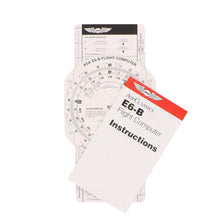Cálculo rápido de vento contrário para pilotos (em 3 etapas fáceis)
Descobrir a configuração correta de vento contrário não precisa ser um processo complicado.
Na verdade, com apenas alguns passos simples, você pode descobrir tudo em minutos!
Os pilotos sabem o quanto é importante ter dados precisos sobre o vento, mas nem todos sabem exatamente como obter essas informações sem realizar alguns cálculos bem complicados.
Se você é uma dessas pessoas, não se preocupe! Este guia vai te guiar por isso.

Featured Pilot Gear
Browse our selection of high-quality pilot supplies! Your purchase directly supports our small business and helps us continue sharing valuable aviation content.
Obtenha configurações precisas de vento contrário em minutos!
Descobrir a configuração correta de vento contrário não precisa ser um processo complicado.
Na verdade, com apenas alguns passos simples, você pode descobrir tudo em minutos!
Os pilotos sabem o quanto é importante ter dados precisos sobre o vento, mas nem todos sabem exatamente como obter essas informações sem realizar alguns cálculos bem complicados.
Se você é uma dessas pessoas, não se preocupe! Este guia vai lhe mostrar uma maneira rápida e eficaz de calcular vento de proa (e um pouco de vento cruzado também) sem passar por nenhuma dor de cabeça.
Vamos lá!
RESUMO
-
Etapa 1: Reúna informações sobre o vento e a pista.
-
Etapa 2: Divida os componentes do vento (vento contrário, vento cruzado).
-
Etapa 3: use a fórmula simples do vento contrário.

Etapa 1: Reúna informações sobre o vento e a pista
O primeiro passo para descobrir como calcular um componente de vento contrário é saber exatamente com o que você está trabalhando. Antes mesmo de pensar em tirar sua aeronave do chão, você precisará obter dados de vento e pista.
Um relatório METAR é um ótimo lugar para começar. Ele fornece a direção e a velocidade do vento — duas coisas que você não pode ignorar se estiver voando contra ventos de frente ou querendo se beneficiar de ventos de cauda.
Exemplo:
Ao olhar para o METAR, você verá a velocidade do vento listada em nós e a direção relativa ao norte verdadeiro.
No caso do nosso exemplo, o vento está soprando de 110 graus a uma velocidade de 3 nós.
O rumo da pista geralmente é marcado no layout do aeroporto, mas você também pode verificar o rumo magnético da pista diretamente no solo ou por meio de suas ferramentas de planejamento de voo.
Lembre-se de que a direção do vento é dada em graus a partir do norte verdadeiro, enquanto as pistas são identificadas por sua direção magnética, então é bom saber a diferença.

Descobrindo o vento contrário com uma meia de vento
Uma manga de vento mostra a direção do vento apontando sua extremidade estreita para onde o vento está soprando, e a extremidade mais larga voltada para o vento.
A velocidade do vento é indicada pela extensão da manga de vento, sendo que uma extensão total significa que o vento está a 15 nós ou mais.
Depois de obter as informações sobre o vento e a pista, você pode começar a decompor as coisas. Fique de olho na velocidade do vento — qualquer coisa acima de 15 nós pode significar que você precisa levar em conta ventos cruzados, que abordaremos mais tarde.
Etapa 2: decompor os componentes do vento
Agora que você reuniu suas informações, é hora de dividir as coisas em componentes.
O vento pode ser algo complicado de lidar, especialmente quando ele vem em um ângulo em relação à sua trajetória de voo. Mas tudo bem, porque dividi-lo em componentes de vento de proa e vento cruzado torna mais fácil lidar com ele.
Você precisará determinar quanto do vento está empurrando diretamente contra o seu avião (vento de proa) e quanto está vindo da lateral (vento cruzado).
Use este método básico: se o vento estiver diretamente alinhado com sua pista, é tudo vento de proa ou de cauda, dependendo da direção. Mas se o vento estiver vindo de um ângulo, apenas uma parte dele contribui para o vento de proa, enquanto o resto se transforma em vento cruzado.
Digamos que você tenha uma direção do vento de 110° e um rumo de pista de 080°. Como o vento não está perfeitamente alinhado, parte dele se torna vento cruzado, enquanto o resto conta como vento de frente.
Se parece complicado agora, conforme você voa mais, você descobrirá que precisa ter uma noção desses ângulos.

Etapa 3: Aplique a fórmula
Agora, é aqui que as coisas ficam ainda mais fáceis. Você tem a direção e a velocidade do vento, e agora é hora de colocá-las em uma fórmula para obter rapidamente sua composição de vento contrário.
Aqui está a fórmula simples:
Vento contrário = Velocidade do vento × cos(Diferença de ângulo)
Onde a diferença angular é o ângulo entre a direção do vento e o rumo da pista.
Vamos dividir:
-
Calcule o ângulo entre o rumo da pista e a direção do vento. Exemplo: se o vento está vindo de 110° e você está usando um rumo de pista de 080°, a diferença de ângulo é de 30°.
-
Encontre o cosseno da diferença angular. Para 30°, isso é aproximadamente 0,86 (use uma calculadora ou tabela de referência, se necessário).
-
Multiplique esse cosseno pela velocidade do vento. Se a velocidade do vento for de 3 nós, seu componente de vento contrário seria 30 × 0,86 = 2,59 nós. Arredonde para 2,6 nós.
E é isso — você tem seu vento contrário! Se a diferença de ângulo for maior, seu componente de vento cruzado aumentará, e seu componente de vento contrário diminuirá. Mas não se estresse com esses cálculos. Você pode usar muitas ferramentas online, ou melhor ainda, uma calculadora E6B simples para fazer o trabalho pesado para você.

Descobrindo seus componentes eólicos usando um E6B
O ASA E6B tem instruções sobre como fazer todos os cálculos impressos diretamente no computador de voo.
Depois de ler seu METAR e obter as informações sobre o vento e sua direção, você pode usar as grades disponíveis na parte traseira do seu E6B.

|
Cor ASA E6BO Color E6B da ASA pega o computador de voo manual "whiz wheel" padrão e o atualiza com toques de cores marcantes. Embora idêntico em funcionalidade e tamanho ao seu ASA-E6B padrão, esta versão do computador de voo de alumínio sólido utiliza uma variedade de cores para significar suas várias funções. |
Considerações adicionais sobre ventos (breve visão geral dos ventos cruzados)
Embora ventos contrários e de cauda sejam geralmente a principal preocupação, não se esqueça dos ventos cruzados. Pousos com vento cruzado podem ser complicados, e é sempre uma boa ideia calcular o componente de vento cruzado antes de decolar.
Você pode usar um processo semelhante ao acima: basta substituir o seno pelo cosseno na fórmula para calcular o componente do vento cruzado.
Ventos cruzados empurrarão seu avião para o lado e, se você não estiver preparado, isso pode tornar as decolagens e pousos um pouco arriscados.
Se estiver trabalhando com um vento cruzado forte, você precisará ajustar sua abordagem ou usar uma pista diferente, se houver uma disponível. Confira nosso guia completo sobre como calcular ventos cruzados para dicas mais detalhadas sobre como lidar com isso. É melhor aprender o máximo possível sobre ventos no caso de precisar fazer um pouso com vento cruzado.

Perguntas frequentes
-
Quão precisos são os cálculos de vento contrário?
Os cálculos de vento contrário geralmente são bem precisos quando você tem os dados certos. Usar um relatório METAR e aplicar a fórmula lhe dará um resultado próximo o suficiente para planejar seu voo com segurança.
Não é preciso ser exato até a casa decimal, mas chegar a um ou dois nós geralmente é suficiente.
-
E se a direção do vento mudar durante o voo?
Mudanças de vento acontecem o tempo todo, especialmente em altitudes mais elevadas. Se você notar a mudança do vento enquanto estiver voando, seus instrumentos de bordo geralmente captarão a diferença.
Ajuste seu rumo ou velocidade conforme necessário e fique sempre atualizado sobre as previsões meteorológicas antes da partida e durante o voo.
-
O que devo fazer se não tiver acesso a um METAR?
Em algumas áreas remotas, você pode não ter acesso a um relatório METAR. Nesse caso, use qualquer serviço meteorológico disponível ou ATIS no seu destino para obter as informações de vento que você precisa.
Se tudo mais falhar, converse com outros pilotos na área ou confie em suas próprias observações de mangas de vento ou pontos de referência locais.
-
Posso estimar o vento cruzado sem uma calculadora?
Sim! A estimativa do vento cruzado pode ser feita visualmente, observando o ângulo do vento em relação à pista. Quanto mais próximo o ângulo estiver de 90 graus, mais forte será o vento cruzado.
Se o vento estiver soprando a menos de 30 graus da direção da pista, a maior parte será vento contrário e apenas uma pequena parte será vento cruzado.
Remover
Calcular ventos contrários não precisa ser assustador, mesmo que pareça um pouco complicado no começo. Apenas respire fundo antes de se aproximar e divida as coisas em passos simples e curtos — reunindo informações sobre vento e pista, descobrindo os componentes do vento e usando uma fórmula — você pode obter rapidamente os números de que precisa. E quando ventos cruzados entram em cena, basta aplicar um método semelhante e você estará pronto para ir!
Voar com cálculos precisos de vento em mente pode ajudar você a gerenciar melhor sua aeronave, proporcionando decolagens e pousos mais suaves.
Não importa se você está voando contra ventos fortes ou enfrentando ventos cruzados, estar preparado mantém você no controle e torna seu voo muito mais seguro.
Boa sorte voando e sempre confira os relatórios de vento!
Interessado em saber mais?
Nossos guias foram projetados para ajudar!
-
Cálculo rápido de vento cruzado para pilotos (em 3 etapas fáceis)
-
Pouso com vento cruzado: como aperfeiçoar sua técnica em 3 etapas fáceis
Você achou este artigo útil?
Você acha que esquecemos de algo importante? Deixe-nos saber nos comentários abaixo!






























